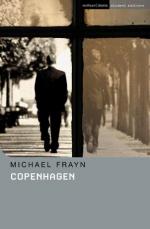|
This section contains 302 words (approx. 1 page at 400 words per page) |

|
Copenhagen Summary & Study Guide Description
Copenhagen Summary & Study Guide includes comprehensive information and analysis to help you understand the book. This study guide contains the following sections:
This detailed literature summary also contains Bibliography on Copenhagen by Michael Frayn.
The play does not provide a clear answer to the question of what took place during that meeting. It does, however, provide a lot of background information about these two powerful thinkers and the struggles they must have encountered in their attempt to honor their friendship during extremely turbulent, even life-threatening, circumstances. Both scientists were capable of figuring out how to create an atomic bomb. Bohr would eventually help the U.S. forces and he was instrumental in the creation of the atomic bombs that were dropped on the Japanese cities of Hiroshima and Nagasaki. But what happened to Heisenberg? Did he deliberately confound the Nazi efforts to create a similar weapon? Or did he attempt to create it but fail? Frayn leaves these overarching questions for the audience to ponder.
Margrethe Bohr is another character in this play. She was, in real life, an intelligent woman and a supporter of her husband. Although she did not have a science education like her husband, she typed all his research papers and was a strong sounding board for his theories. In the play, it is to Margrethe that the two men direct their discussion. They attempt, for her sake (and the sake of any nonscientific audience members), to translate their technological information into a language that everyone can understand. Margrethe also acts as a mediator and as a truth monitor. She makes the men look deeper into their actions, and insists that they shun personal emotion and get to the root of what is really going on between them.
Copenhagen opened on May 28, 1998, in London, at the Cottesloe Theatre. Two years later, it made its U.S. premiere at New York's Royale Theatre, on March 23, 2000. Since then, it has traveled around the world, receiving overwhelmingly high praise as a dramatic piece.
Read more from the Study Guide
|
This section contains 302 words (approx. 1 page at 400 words per page) |

|



